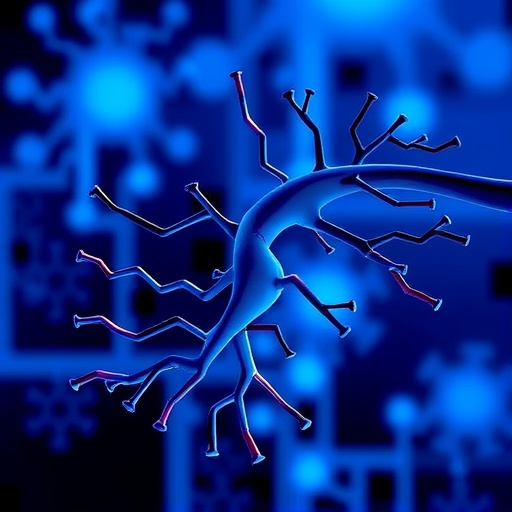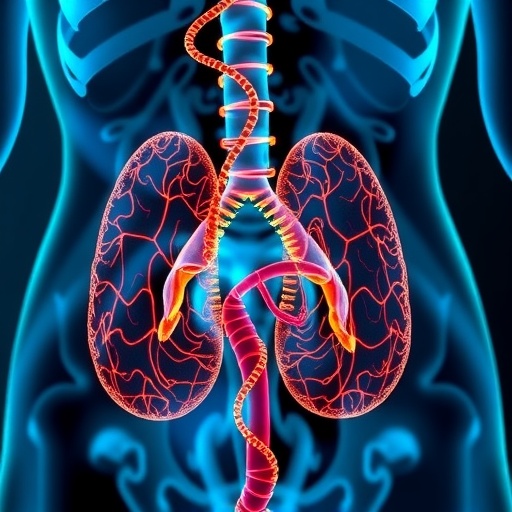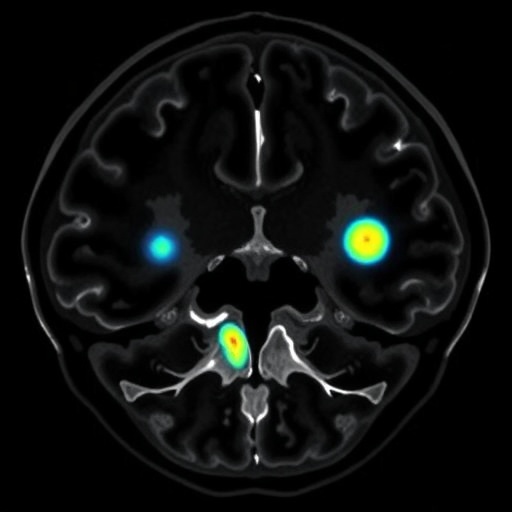The formation of neutrophil extracellular traps, commonly known as NETs, has emerged as a groundbreaking area of study within cancer biology, unraveling new dimensions of tumor progression and immune system interplay. These intricate web-like structures, composed primarily of DNA fibers and antimicrobial proteins, originate from neutrophils—a pivotal component of the innate immune system traditionally known for combating infections. Recent research has illuminated the multifaceted role of NETs beyond their antimicrobial functions, implicating them directly in promoting cancer development and metastasis. Understanding how NETs are generated and regulated within the tumor microenvironment is now considered a crucial step toward designing innovative therapeutic strategies against cancer.
Neutrophils, the most abundant type of white blood cells, execute their defense mechanisms not only through phagocytosis and degranulation but also by ejecting NETs. This aggressive mode of action traps and neutralizes invading pathogens. However, cancer cells exploit this mechanism, hijacking the NET formation process to facilitate their own survival and dissemination. The intricate dance between tumor cells and neutrophils culminates in a pathological cycle where NETs create a pro-tumorigenic niche. This discovery has led researchers to delve deeper into the molecular cascades triggering NETosis—the process of NET formation—in cancerous settings, revealing an elaborate network of signaling molecules and cellular interactions that drive this phenomenon.
Recent breakthroughs have highlighted key molecular players that mediate NETosis in cancer. Reactive oxygen species (ROS), enzyme effectors like neutrophil elastase (NE), and peptidylarginine deiminase 4 (PAD4) emerge as central orchestrators of chromatin decondensation and release in neutrophils. The tumor microenvironment often presents oxidative stress, inflammatory cytokines, and chemokines that induce these pathways, pushing neutrophils toward NET formation. Precisely how these signaling axes differ between physiological immune responses and pathological cancer contexts continues to churn as an active area of research. Understanding this distinction is paramount for therapeutic targeting that minimizes damage to normal immune functions.
Moreover, researchers have elucidated that NETs act as physical and biochemical scaffolds within tumors, capturing circulating tumor cells and facilitating metastatic seeding at distant organs. This entrapment effect significantly contributes to cancer spread, a primary cause of mortality among patients. Investigations into the structural composition of NETs reveal a rich milieu of proteases and cytokines tethered to the chromatin matrix, which collectively remodel the extracellular environment. Such remodeling influences tumor cell adhesion, survival, and evasion of immune surveillance. This dualistic role of NETs—as defenders in infections and inadvertent accomplices in cancer progression—encapsulates the complexity of immune regulation within oncogenic processes.
The involvement of NETs also extends to resistance mechanisms against conventional cancer therapies. Studies suggest that NETs induce a physical barrier limiting the penetration of chemotherapeutic agents, thereby dampening treatment efficacy. Furthermore, components of NETs may activate survival pathways in tumor cells, rendering them more resilient to apoptosis induced by drugs or radiation. These insights open new avenues for designing adjunct therapies that disrupt NET formation or facilitate their degradation to sensitize tumors to existing treatments. Targeted inhibition of PAD4 or use of DNase enzymes to dismantle the NET framework has gained traction as promising strategies in preclinical models.
Interdisciplinary research utilizing advanced imaging techniques, proteomics, and genetic models has been pivotal in mapping NET formation and function in vivo. Fluorescent microscopy coupled with intravital imaging provides real-time visualization of NETs within tumors and metastatic niches, revealing spatial and temporal dynamics previously inaccessible. Mass spectrometry-based proteomic profiling uncovers the diverse array of proteins bound to NETs, offering a comprehensive view of their biochemical signature. Genetic knockout models of PAD4 or NE help delineate the consequences of disrupted NETosis on tumor progression, reinforcing the critical nature of these enzymes. This integrative approach accelerates the translation of fundamental mechanistic knowledge into clinically actionable interventions.
Additionally, the crosstalk between NETs and other immune cells adds an extra layer of complexity to tumor immunity. NET-associated proteins modulate the activity of macrophages, dendritic cells, and lymphocytes, influencing their phenotype and function within the cancer milieu. For example, NETs may skew macrophages toward a tumor-promoting M2 phenotype or suppress cytotoxic T cell responses, tipping the immunological balance in favor of tumor survival. These immunomodulatory effects help explain why tumors with abundant NET presence often correlate with poor prognosis. Capturing these interactions opens a window for immunotherapeutic modulation, aiming to restore effective anti-tumor immunity.
Beyond primary tumors, NETs have been implicated in cancer-associated thrombosis, a serious complication that worsens patient outcomes. NETs provide a scaffold for platelet adhesion and fibrin deposition, triggering thrombus formation within blood vessels. This prothrombotic environment exacerbates tumor burden and increases mortality risks due to embolic events. Insights into how cancer escalates NET-mediated thrombosis have propelled investigations into anticoagulant therapies that also target NET structure or formation, presenting dual benefits. This connection highlights the broad systemic impact of NETs in cancer pathology, extending well beyond localized tumor growth.
Clinical correlations further underscore the significance of NET biology in cancer prognosis and diagnosis. Elevated circulating levels of NET components serve as biomarkers predictive of metastasis and survival rates across multiple cancer types including lung, breast, and pancreatic cancers. The quantification of these markers in patient blood samples offers a minimally invasive tool for disease monitoring and therapeutic response assessment. Future research aims to refine such biomarker panels and integrate them into precision medicine frameworks. This translational aspect cements NET research not only as a basic science triumph but also as a driver of improved patient care.
Exploring pharmacological inhibitors that specifically target NET formation is rapidly gaining momentum. Several small molecules and biologics that hinder PAD4 activity, ROS production, or enzymatic release from neutrophils show promising anticancer potential. Early-stage clinical trials are underway to assess their safety and efficacy, marking a hopeful horizon for adjunctive therapies. Additionally, combinational regimens incorporating NET inhibitors with immunotherapies, chemotherapy, or targeted agents are under exploration to maximize therapeutic outcomes. The prospect of disrupting a fundamental tumor-supportive mechanism without broadly suppressing immunity offers a highly attractive therapeutic window.
The heterogeneity of NET formation in different cancer types and stages suggests that personalized approaches may be necessary. Tumor genetics, microenvironmental cues, and patient immune status collectively influence how NETosis is regulated. Deciphering these context-dependent variables requires large-scale integrative studies encompassing genomics, proteomics, and immune profiling. This will enable stratification of patients who might benefit most from NET-targeted interventions and avoid unintended immune compromise. Such precision medicine paradigms are becoming an essential aspect of modern oncology.
Excitingly, the study of NETs intersects with emerging fields such as cancer metabolism and epigenetics. Metabolic alterations within neutrophils affect their capacity for NET release, while epigenetic modifications regulate the expression of enzymes critical for NETosis. These discoveries provide novel checkpoints for intervention and hint at broader systemic changes that accompany oncogenesis. By incorporating metabolic and epigenetic dimensions into the understanding of NET biology, scientists hope to unearth multifaceted targets that simultaneously disrupt tumor support and enhance immune function.
Ethical considerations and safety remain paramount as NET-directed therapies advance toward clinical application. Given the indispensable role of neutrophils in infection control, therapies must be carefully designed to avoid predisposing patients to opportunistic infections. Balancing effective suppression of pathological NETs with preservation of host defense mechanisms is a delicate endeavor. Ongoing and future clinical studies will need to vigilantly monitor adverse effects while validating therapeutic benefits. The evolving field of cancer immunology stands ready to embrace these challenges while applying innovative biological insights.
In conclusion, the expanding mechanistic understanding of NET formation in cancer has revolutionized perspectives on tumor-immune interactions and opened new therapeutic frontiers. From molecular underpinnings and immune modulation to clinical implications and drug development, research is rapidly unraveling the complex roles that NETs play in malignancy. The intricate balance between their protective and pathological functions underscores the sophistication of immune-tumor crosstalk. As the science advances, integrating NET biology into comprehensive cancer care promises to improve outcomes and offer hope for patients facing the devastating consequences of cancer metastasis.
Subject of Research: Mechanistic understanding of neutrophil extracellular traps (NETs) formation in cancer and their role in tumor progression and metastasis.
Article Title: Progress in the mechanistic understanding of NETs formation in cancer.
Article References:
Luo, C., Xiong, X., Fang, C. et al. Progress in the mechanistic understanding of NETs formation in cancer. Med Oncol 42, 451 (2025). https://doi.org/10.1007/s12032-025-03010-x
Image Credits: AI Generated
Tags: Advances in NETs formation researchcancer biology breakthroughsMechanisms of immune evasion in cancerNETosis signaling pathwaysNETs and cancer metastasisNETs and innate immune responseNeutrophil extracellular traps in cancerPro-tumorigenic effects of NETsRole of neutrophils in cancerTherapeutic strategies targeting NETstumor microenvironment interactionsTumor progression and immune system






